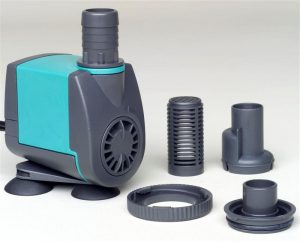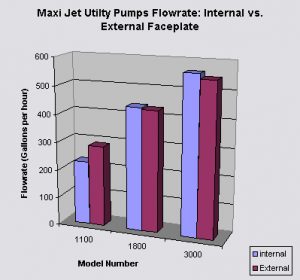For years the Maxi Jet line of pumps has been one of the most popular powerheads of the aquarium hobby. Originally designed for general circulation and powering undergravel filters, the pumps have been reapplied for powering skimmers, reactors, media filters and there are modification kits available which elegantly convert the centrifugal pumps into propeller pumps. The pumps’ only drawback was that the largest model had a maximum flow rate just shy of 300 gallons per hour. Enter 2008 and the Maxi Jet line has finally been revamped to include more powerful models known as the Maxi Jet Utility (MJU) pumps. This review features the three largest currently available models, the MJU 1100, MJU 1800 and MJU 3000, although two larger models are scheduled to be released in the near future.

Maxi Jet Utility 3000 pump shown with the internal use faceplate, including the flow controlling intake screen and disc. Note the two screws used for removing this faceplate.
First Impressions
The packaging on the outside of the box is surprisingly useful. The front panel clearly states the model number, maximum flow rate and expected flow rate at four feet of head pressure. Although many pump manufacturers include some kind of flow curve for larger pumps, it is useful for hobbyist to know how a pump will perform at a typical height for flow return from a sump. The MJU pumps come with a 3-year warranty and I expect them to be dependable. Out of the box the pumps have a good feel when handled, the parts fit together tightly yet most of the adjustments and conversions can be performed without the use of tools. Just like the classic Maxi Jets, the MJU pumps come with a slew of parts and fittings to get the maximum functionality for a range of applications but the pumps have a two-prong, ungrounded plug. The parts include (temporarily useful) suction cups, male threaded barb fittings with an o-ring seal and the internal and external use faceplates.
Internal or External Use
One of the main changes which differentiate the Maxi Jet Utility line from the classic Maxi Jets is their ability to be converted from an internal powerhead or pump to an external pump simply by switching the faceplate. The faceplates of the MJU 1100 are snap on but the larger MJU 1800 and 3000 have two stainless steel screws which firmly fasten the internal use faceplate. All of the internal use faceplates have a flow adjustment “disc” which doubles as an intake screen. This built-in flow control is useful for quick adjustment of the flow rate but when used in a reef this disc will likely be difficult to adjust once it becomes bio-fouled by encrusting organisms if it is not frequently cleaned. Furthermore, all the MJU pumps have a female threaded outlet, ½” for the MJU 1100 and ¾” for the MJU 1800 and 3000, and the external use faceplates have female threaded inlets of the same size. The inlet and outlet threads can accept the included barbed adapter or they can be hard
plumbed using standard PVC fittings.

The Maxi Jet Utility 1100 pump is shown here with the internal use faceplate and the parts for conversion to external or inline use which can be changed over without tools.
Comparisons
The MJU 1100 seems identical to the beloved Maxi Jet 1200 in power draw and flow output. Both have a maximum flow rate of 294 GPH, a 21 watt power draw and have very similar shape and size. I suspect that both pumps use the same motor however they do use slightly different impellers. Interestingly, the impeller has switched from an internal bearing design where the magnet and impeller spin freely around a central shaft to an external bearing design where the magnet and impeller are fixed to the shaft with the bearings at either ends of the shaft. Presumably this design change yields an increase in efficiency. The MJU 1100 housing is more suited for switching between internal or external use and the external use faceplate will accept the standard intake screen that comes with both the MJ 1200 and the MJU 1100. Additionally, unlike the MJU 1100, the MJ1200 cannot be (safely) hard plumbed with PVC fittings as it does not have a threaded inlet or outlet.

A Maxi Jet 1200 is shown here next to the similar yet more versatile Maxi Jet Utilty 1100. Note the change in impeller design; the MJ1200 has an impeller with an internal bearing and the MJU 1100 impeller has an external bearing.
The MJU 1800 is rated for a maximum of 475 GPH and an expected 255 GPH at four feet of head pressure with a maximum power draw of 38 Watts. Both the flow rates and the power draw of the MJU 1800 are in between a Mag-Drive 3 and Mag-Drive 5 in values but the MJU 1800 is noticeably quieter than either Mag-Drive models. Furthermore, with all of the included components the MJU 1800 has more varied functionality than a Mag-Drive which only includes an intake strainer and pre-filter.
Finally, the MJU 3000 is rated for a maximum of 775 GPH and an expected flowrate of 500 GPH at four feet of head pressure with a maximum power draw of 58 Watts. The performance values of the MJU 3000 compare to a Mag-Drive 7 and an Eheim 1260, both of which have a power draw of 60 Watts and comparable pressured flow rates. Like the Eheim 1260 the MJU 3000 is virtually silent whereas the Mag-drive 7 is noticeably audible. Also, the MJU 3000 is about the same size as a Mag-drive 7 but it is noticeably smaller than the hunk of a pump which is the Eheim 1260.

The Maxi Jet Utility 3000 is shown here sandwiched between some usual suspects, a Mag-drive 7 on the left and an Eheim 1260 on the right.
Testing
Specifications obtained under carefully controlled testing conditions are useful for knowing how well equipment can perform but a new product has no street credentials until it is tested and used under real world conditions. The Maxi Jet Utility pumps were tested for flow rate and power consumption. Power draw was measured using the Kill-A-Watt as featured by Dana Riddle in last month’s issue and the flow rate was measured using a King Instruments rotameter (the rotameter adds 18 inches of pressure which was accounted for in these tests). One of the first things I wanted to test was how the MJU pumps would be affected by using either the internal or external faceplates. Figure 1 shows that there was a significant difference in performance for the MJU 1100 where it pumped about 40 gallons more per hour using the external use faceplate over the internal use faceplate. There was no significant difference in the flow rate of the MJU 1800 or MJU 3000 whether they used the internal or external use faceplates.
Next, the MJU pumps and an MJ 1200 were tested at 18″ and 48″ of head pressure. Figure two shows the results of testing at 18″ and Figure 3 shows the results of testing at 48″ of head pressure. I would have liked to test all the pumps with no head pressure but the rotameter precluded this. As you can see in figure 1, the MJ 1200 pumped slightly less volume than the MJU 1100 at 18″ of head pressure but interestingly, at 48″ of head pressure the MJ 1200 and MJ 1100 pumped the same volume of water while consuming the same amount of power. Otherwise, all the tests show results that are in line with the advertised flow rates and I assume that discrepancies are due to artifacts of how the tests were carried out. The last test I performed was to measure how much the MJ 1200 and MJU 1100 pumped through a classic AquaC Remora hang-on protein skimmer. This test was performed by repeatedly timing the fill rate of a known volume and taking the average. Once again there was a negligible
difference in output with the MJU 1100 pumping 92 gallons per hour through the Remora and the MJ 1200 pumping 88 gallons per hour.
Conclusion
Since the end of the metric tests I have had all three pumps in use for a range of applications. The MJU 1100 is powering an AquaC Remora while producing a similar output of skimmate as I would expect from the MJ 1200 I previously used. The MJU 1800 is providing return from a sump for a 110 gallon fish tank and the MJU 3000 is currently driving a small tiered propagation system with outputs at 4 feet and 6 feet from the sump. I am getting a reasonable flow rate from both pumps and I am especially pleased with how quiet they are. Although there is no manufacturer suggested retail price, the pumps will likely retail at $50-60 for the MJU 1100, $70-80 for the MJU 1800 and $120-130 for the MJU 3000. The pumps are not breaking any ground in terms of performance or efficiency, but with the Maxi-Jet reputation and a 3 year warranty I find great value in the Maxi Jet Utility line’s versatility and even more value in their quietness.






0 Comments